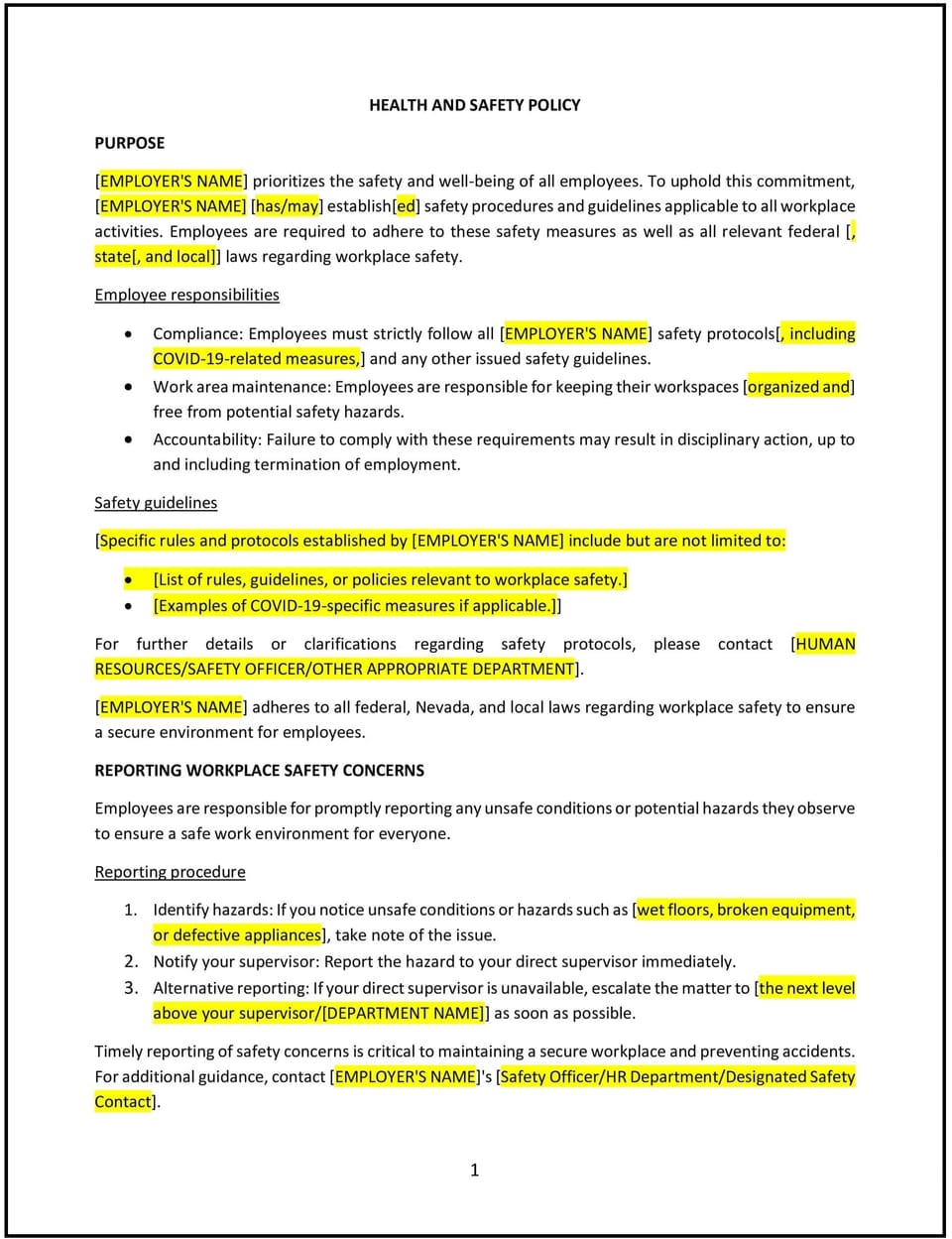Health and safety policy (Nevada): Free template

Health and safety policy (Nevada)
This health and safety policy is designed to help Nevada businesses establish and maintain a safe working environment for all employees. It outlines the company’s commitment to identifying and mitigating workplace hazards, promoting employee well-being, and complying with state and federal health and safety regulations.
By adopting this policy, businesses can reduce workplace incidents, promote compliance with legal requirements, and foster a culture of safety and accountability.
How to use this health and safety policy (Nevada)
- Identify workplace hazards: Conduct regular assessments to identify potential hazards in the workplace and take appropriate measures to eliminate or mitigate risks.
- Establish safety protocols: Develop clear procedures for handling equipment, hazardous substances, and emergencies, ensuring employees are well-informed about safety protocols.
- Provide safety training: Offer regular training sessions for employees to educate them on workplace safety practices, emergency procedures, and the proper use of equipment or protective gear.
- Assign safety responsibilities: Designate specific individuals or teams to oversee workplace safety, such as safety officers or managers. Ensure they are equipped to handle safety-related concerns and conduct inspections.
- Ensure compliance: Regularly review workplace practices to ensure they meet Nevada’s Occupational Safety and Health Administration (OSHA) regulations and any applicable federal standards.
- Promote incident reporting: Encourage employees to report workplace hazards, near misses, or injuries promptly and without fear of retaliation.
- Maintain records: Keep detailed records of safety incidents, training sessions, inspections, and corrective actions to monitor trends and ensure continuous improvement.
- Review and update policies: Periodically review and revise the health and safety policy to reflect changes in regulations, workplace conditions, or identified hazards.
Benefits of using this health and safety policy (Nevada)
This policy provides several key benefits for Nevada businesses:
- Reduces workplace accidents: Clear guidelines and proactive measures help minimize the risk of injuries and accidents.
- Enhances legal compliance: Improves adherence to Nevada OSHA and federal health and safety regulations, reducing the risk of fines or legal liabilities.
- Improves employee morale: A commitment to health and safety fosters trust and confidence among employees, contributing to higher morale and productivity.
- Promotes a culture of safety: Encourages employees to prioritize safety and hold one another accountable for maintaining a secure work environment.
- Minimizes downtime and costs: Reducing workplace incidents helps avoid disruptions to operations and lowers costs associated with injuries or property damage.
Tips for using this health and safety policy (Nevada)
- Communicate the policy clearly: Ensure that all employees understand the policy and their responsibilities in maintaining a safe workplace. Include the policy in onboarding materials and conduct regular safety briefings.
- Conduct regular inspections: Schedule routine workplace inspections to identify and address potential hazards before they lead to incidents.
- Involve employees: Encourage employee participation in safety initiatives, such as forming a safety committee or soliciting feedback on potential improvements.
- Respond promptly to concerns: Address reported safety concerns quickly to demonstrate the company’s commitment to employee well-being and workplace safety.
- Use technology: Implement tools such as incident tracking software or digital checklists to streamline safety management and improve record-keeping.
Q: What steps should businesses take to ensure workplace safety?
A: Businesses should conduct regular hazard assessments, provide employee training, implement clear safety protocols, and encourage incident reporting to maintain a safe work environment.
Q: Who is responsible for health and safety in the workplace?
A: While maintaining a safe workplace is a shared responsibility, businesses should designate safety officers or managers to oversee safety efforts and address specific concerns.
Q: How can employees report workplace hazards or incidents?
A: Employees can report hazards or incidents by notifying their supervisor, safety officer, or HR. Businesses should establish a clear reporting process to encourage prompt communication.
Q: What type of safety training should businesses provide?
A: Businesses should offer training on workplace hazards, emergency procedures, the proper use of equipment, and any industry-specific safety requirements. Training should be conducted during onboarding and periodically thereafter.
Q: How often should businesses review their health and safety policy?
A: The policy should be reviewed at least annually or whenever there are changes in Nevada OSHA regulations, workplace conditions, or identified safety concerns.
Q: Are businesses required to maintain safety records?
A: Yes, businesses should maintain detailed records of incidents, inspections, training, and corrective actions to ensure compliance with regulations and identify trends for continuous improvement.
Q: How can businesses promote a culture of safety?
A: Businesses can promote safety by encouraging employee involvement in safety initiatives, providing regular training, recognizing safe practices, and responding promptly to concerns or incidents.
This article contains general legal information and does not contain legal advice. Cobrief is not a law firm or a substitute for an attorney or law firm. The law is complex and changes often. For legal advice, please ask a lawyer.


